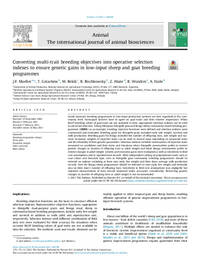Converting multi-trait breeding objectives into operative selection indexes to ensure genetic gains in low-input sheep and goat breeding programmes

Authors:
Small ruminant breeding programmes in low-input production systems are best organised at the community level. Participant farmers have to agree on goal traits and their relative importance. When BLUP breeding values of goal traits are not available in time, appropriate selection indexes can be used to aid visual selection. Taking Ethiopian Abergelle goat and Bonga sheep community-based breeding programmes (CBBPs) as an example, breeding objective functions were defined and selection indexes were constructed and evaluated. Breeding goals for Abergelle goats included early sale weight, survival and milk production. Breeding goals for Bonga included the number of offspring born, sale weight and survival. Economic weights of objective traits can be used in several ways depending on measured traits and the reliability of their genetic parameters. Selection indexes included combinations of objective traits measured on candidates and their dams and situations when Abergelle communities prefer to restrict genetic changes in number of offspring born or adult weight and when Bonga communities prefer to restrict changes in adult weight. Genetic and economic gains were evaluated as well as sensitivity to feed cost assumptions and to repeated dam records. After independent culling on preponderant traits such as coat colour and horn/tail type, sires in Abergelle goat community breeding programmes should be selected on indexes including at least own early live weight and their dams average milk production records. Sires for Bonga sheep programmes should be selected on own early live weight and desirably also on their dam’s number of offspring born. Sensitivity to feed cost assumptions was negligible but repeated measurements of dam records improved index accuracies considerably. Restricting genetic changes in number of offspring born or adult weight is not recommended.
